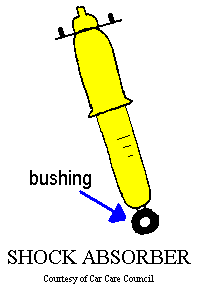PROPER CARE
Inspecting Your Shocks
*EASY*
Conventional shock absorbers and struts do not require any maintenance but should be inspected every six months. Use the following procedure to inspect your shock absorbers or struts:
- Park the vehicle on level ground with the engine OFF, the parking brake engaged, and the transmission in PARK (for automatic) or REVERSE (for manual). Be certain that all tires are properly inflated.
- Quickly and firmly push down on one corner of your car and release it immediately. The car should bounce up once, then down once (but only 1/2 the initial distance) and then stop on the way up. If your car bounces more than 1 1/2 times, that is, reaches an upper rebound point twice, the shock absorber or strut is worn and must be replaced. Test all four shock absorbers or struts this way.
- Next, crawl underneath the car and look for fluid leaks on or from shock
absorbers. Pay special attention to weak shocks identified above.
Inspect the rubber bushings for damage or wear. If the shock absorber bushings are damaged, or if the shock leaks fluid, it must be replaced. Leaking shocks cannot be repaired; they must be replaced. - View your car at distance from all directions, front and back, then both
sides. It should set level if all shock absorbers and springs are in good
working order. If your car leans slightly, a shock or spring is loose, worn, or
broken. Have it serviced.
Shock absorbers and struts should be replaced when necessary. However, any shock absorber replacement should be done by a professional automotive technician since special tools and skills are required.

